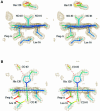Unprecedented proximal binding of nitric oxide to heme: implications for guanylate cyclase
- PMID: 11060017
- PMCID: PMC305806
- DOI: 10.1093/emboj/19.21.5661
Unprecedented proximal binding of nitric oxide to heme: implications for guanylate cyclase
Abstract
Microbial cytochromes c' contain a 5-coordinate His-ligated heme that forms stable adducts with nitric oxide (NO) and carbon monoxide (CO), but not with dioxygen. We report the 1.95 and 1.35 A resolution crystal structures of the CO- and NO-bound forms of the reduced protein from Alcaligenes xylosoxidans. NO disrupts the His-Fe bond and binds in a novel mode to the proximal face of the heme, giving a 5-coordinate species. In contrast, CO binds 6-coordinate on the distal side. A second CO molecule, not bound to the heme, is located in the proximal pocket. Since the unusual spectroscopic properties of cytochromes c' are shared by soluble guanylate cyclase (sGC), our findings have potential implications for the activation of sGC induced by the binding of NO or CO to the heme domain.
Figures




Similar articles
-
Resonance Raman studies of cytochrome c' support the binding of NO and CO to opposite sides of the heme: implications for ligand discrimination in heme-based sensors.Biochemistry. 2001 Apr 3;40(13):4115-22. doi: 10.1021/bi0023652. Biochemistry. 2001. PMID: 11300792
-
Six- to five-coordinate heme-nitrosyl conversion in cytochrome c' and its relevance to guanylate cyclase.Biochemistry. 2002 Feb 19;41(7):2353-60. doi: 10.1021/bi011419k. Biochemistry. 2002. PMID: 11841228
-
Binding of nitric oxide and carbon monoxide to soluble guanylate cyclase as observed with Resonance raman spectroscopy.Biochemistry. 1996 Feb 6;35(5):1540-7. doi: 10.1021/bi952440m. Biochemistry. 1996. PMID: 8634285
-
Cytochromes: Reactivity of the "dark side" of the heme.Biophys Chem. 2010 Nov;152(1-3):21-7. doi: 10.1016/j.bpc.2010.09.008. Epub 2010 Oct 16. Biophys Chem. 2010. PMID: 20952122 Review.
-
How do heme-protein sensors exclude oxygen? Lessons learned from cytochrome c', Nostoc puntiforme heme nitric oxide/oxygen-binding domain, and soluble guanylyl cyclase.Antioxid Redox Signal. 2012 Nov 1;17(9):1246-63. doi: 10.1089/ars.2012.4564. Epub 2012 Apr 10. Antioxid Redox Signal. 2012. PMID: 22356101 Free PMC article. Review.
Cited by
-
Nitric oxide binds to the proximal heme coordination site of the ferrocytochrome c/cardiolipin complex: formation mechanism and dynamics.J Biol Chem. 2010 Jun 25;285(26):19785-92. doi: 10.1074/jbc.M109.067736. Epub 2010 Apr 15. J Biol Chem. 2010. PMID: 20395293 Free PMC article.
-
NO binding to naphthalene dioxygenase.J Biol Inorg Chem. 2005 Aug;10(5):483-9. doi: 10.1007/s00775-005-0657-1. Epub 2005 Sep 23. J Biol Inorg Chem. 2005. PMID: 15942729
-
Variation of the axial haem ligands and haem-binding motif as a probe of the Escherichia coli c-type cytochrome maturation (Ccm) system.Biochem J. 2003 Nov 1;375(Pt 3):721-8. doi: 10.1042/BJ20030752. Biochem J. 2003. PMID: 12901720 Free PMC article.
-
The crystal structure of cytochrome P460 of Nitrosomonas europaea reveals a novel cytochrome fold and heme-protein cross-link.Biochemistry. 2007 Jul 17;46(28):8340-9. doi: 10.1021/bi700086r. Epub 2007 Jun 21. Biochemistry. 2007. PMID: 17583915 Free PMC article.
-
Reductive coupling of nitrogen monoxide (*NO) facilitated by heme/copper complexes.Inorg Chem. 2010 Feb 15;49(4):1404-19. doi: 10.1021/ic901431r. Inorg Chem. 2010. PMID: 20030370 Free PMC article.
References
-
- Addison A.W. and Stephanos,J.J. (1986) Nitrosyliron(III) hemoglobin: autoreduction and spectroscopy. Biochemistry, 25, 4104–4113. - PubMed
-
- Brucker E.A., Olson,J.S., Ikeda-Saito,M. and Phillips,G.N.,Jr (1998) Nitric oxide myoglobin: crystal structure and analysis of ligand geometry. Proteins, 30, 352–356. - PubMed
-
- Brünger A.T. (1992) X-PLOR: Version 3.1. A System for X-ray Crystallography and NMR. Yale University Press, New Haven, CT.
-
- Brünger A.T. (1993) Assessment of phase accuracy by cross validation—the free R-value—methods and applications. Acta Crystallogr. D, 49, 24–36. - PubMed
Publication types
MeSH terms
Substances
Associated data
- Actions
- Actions
- Actions
- Actions
LinkOut - more resources
Full Text Sources

